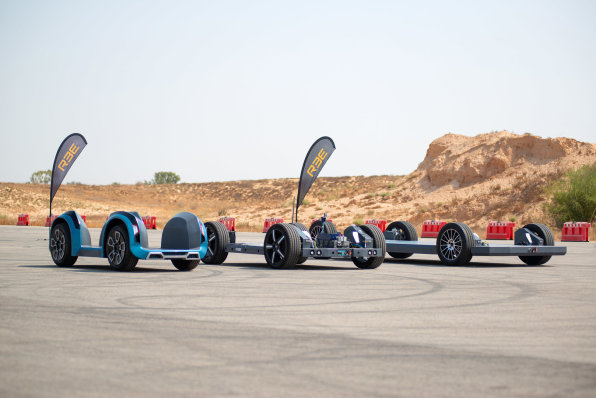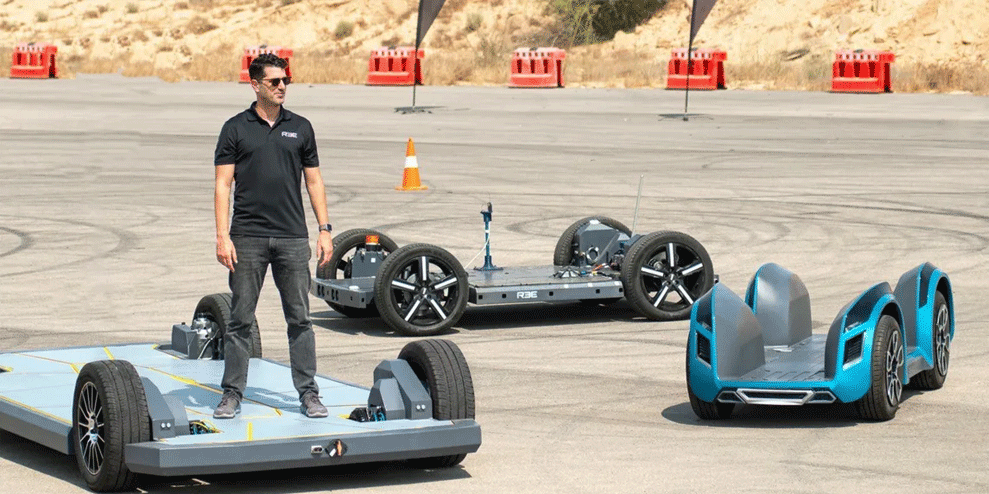Electric vehicles are incredible. Beyond eliminating fossil fuels, they are whisper quiet, accelerate faster than gasoline cars, and according to a new Consumer Reports study, operate with less expensive maintenance over time. But one of the biggest benefits of EVs is that they are revolutionizing the way cars are built.
How? As this new video from Israeli startup Ree demonstrates, the EV of tomorrow is basically just a giant skateboard. With tiny motors placed inside the wheels, the car can assume any form imaginable; any sort of seating or storage arrangement can be built right on top of this flat base.

Traditional gas cars were built atop a flat chassis, too. But that chassis was hardly so self-contained. Components such as your engine and steering system are on top. Then the motor propels a complex series of axles under the car. Of course you have brakes, suspension, cooling systems, gas lines, and other systems to snake around, too. It all adds up to 30,000 parts that are screwed, pressed, glued, and welded together. Today, most modern manufacturing uses robots to frame out the entire car first like a house—from chassis to body—meaning your car’s floorpan is permanent from its earliest moments on the assembly line.Ree was one of our Most Innovative Companies of 2020, and it’s one of several manufacturers working on an alternative platform. Peers include automotive mainstays like VW, newer startups like Rivian, and even Tesla. But Ree’s new video, seen here, is the first time I’ve witnessed the odd spectacle of these flat chassis whipping around a track with no other filigree attached.
The smallest is a nimble EV made for tight turns and small cargo deliveries for last-mile delivery services. The medium is for transporting goods and people short distances. And the largest you see is a full Class 1 vehicle—a typical car or delivery van.
With all components of the drivetrain and steering built into this base, a Ree vehicle doesn’t need the metal frame or plush seating of a cabin to drive. (The skateboards appear to be operated by a remote control for this demo—they are not self-driving.) But seeing how little an EV needs in terms of hardware to functionally drive really cements just how wild and open the future of electric vehicle design will be. Everything from the wheels up can be reimagined.
Such a vision has already been teased by Ideo in one of the most impressive car concepts of the past decade. Ideo proposed an office on wheels. It’s basically a square room where the walls are windows.
Ree is making some of these more aggressive EV thought experiments real (VW is about halfway there with its much-hyped electric bus). Ree’s technology has already been licensed by Toyota for the Japanese car maker’s electric truck subsidiary Hino. In a presentation last year, Hino detailed how this platform could power small city buses, sure, but also beauticians and doctor offices on wheels. Hino even went so far as to detail a mount, which would allow these modular “service spaces” to pop on and off the chassis at will.

How long would that process take? Only long enough to put the cabin on jacks to pull it off the chassis, kind of like you’re changing a spare tire. With the right business model, you could even imagine bringing in your minivan for repair, and rather than giving you a loaner, the dealer just pops off the cabin and sticks it onto a new or refurbished bottom. So your car as you know it would stay the same, but the drivetrain would be new—a process that would take mere minutes.Delivery giants like Amazon are interested in these electric skateboards to power delivery fleets, as it just revealed new electric vans built atop a similar electric platform made by Rivian. For Amazon to have 100,000 EVs on the road by 2030, it needs these vehicles to be simple to repair, with interoperable parts. The skateboard design ensures a delivery vehicle is never out of commission for long.
But what about cars for the rest of us? With a bit more imagination, you can picture consumer vehicles becoming far more personalized, as dozens of aftermarket companies build varying cabins for a skateboard base. Even if you don’t want to buy such a car for yourself, small business owners probably will. Vehicles could mobilize the nature of brick-and-mortar retail and services, much like food trucks shook up the restaurant industry in the mid-aughts. Design studio NewDealDesign has even suggested that, linked together, individual vehicle storefronts could amass to something like a mobile city that can cruise like a parade, or perhaps a mall on wheels. We’re well on our way to a world of wildly diverse vehicles, where design is limited more by the legalese of our road laws than by the creative decisions made by a few big automakers.
This article first appeared in www.fastcompany.com
Seeking to build and grow your brand using the force of consumer insight, strategic foresight, creative disruption and technology prowess? Talk to us at +971 50 6254340 or mail: engage@groupisd.com or visit www.groupisd.com/story

